Yes direct sound measured (1m). My focus on diffraction is an unfinished business and a recent experiment to control the diffraction gave such difference , i will continue the experiment in August.
Also the logsweep measurements with Acourate showed strong reflections of floor and ceiling (And in the Arta measurements) at ~ 4 and ~6 msec.
When i continue i will try to dampen these 2 main reflections as much as possible.
Also the logsweep measurements with Acourate showed strong reflections of floor and ceiling (And in the Arta measurements) at ~ 4 and ~6 msec.
When i continue i will try to dampen these 2 main reflections as much as possible.
Hi macka, I suspect your post was for me as I couldn't find threads by JanRSmith?I have looked through your thread and l’m not sure l accept your simulations.
The underlying fact is that all rooms have a reverberation time which can vary across the audio spectrum. RT60 is the known reference for measurement of reverberation time.
All indirect sound reaching the listener position is time domains related as a dominant factor. The incidence or sound reflections points is determined by the power response of the loudspeaker and the primary first reflection points in the room. Above the Schroder frequency this sound is like rays of light. Below the Schroder frequency the sounds is represented as modal frequencies that either peak or null.
With your simulations or measurements if taken in a snapshot in time you will only see the direct sound at that time slice. All the first reflections arrive latter. That is the reverberant sound of the room. These reflections can only be removed with absorption. Diffusion can be used to scatter reflections.
Critical listening rooms must employ absorption on adjacent surfaces. Typically the ceiling has a cloud to counter the reverberation time as the floor is impractical. These treatments can be useful for modal frequencies with correct design.
The room size has a significant impact on the above. You can measure the above with REW and collect data on a particular room without resorting to simulations which at best are made on assumptions which can lead in incorrect hypothesis and conclusions
In my own experience using Dirac room measurements and correction the visible correction is always below the Schroder frequency. An untreated room will always impact on the reverberation related issues regardless of the loudspeaker or crossover design. Those factors primarily address the on axis direct sound by design. If the power response is uniform it’s a bonus in terms of uniform absorption of the reverberant sound.
The simulations I have posted do not consider room directly, or include room effects, only what speaker output is to each direction. I'm using somewhat typical room and listening situation to calculate the directions from. I'm looking at responses towards the first specular reflections and mostly around crossover between tweeter and woofer, and speculating upon that. You raise important aspects of room interaction like reverberation time and that measurement at listening position follows power response between about Schroeder frequency and very high frequencies, where sound decays faster and overall directivity is already quite narrow which make direct sound dominate over power response. These are all valid things and affect sound of a loudspeaker in room but there is more.
These steady state frequency responses do not show spatial effects, how hearing system perceives the sound image, envelopment and things alike hard to measure. This is what interests me and is subject in this thread, if we can dig bit deeper than the lumped power response or DI or in-room response and if can connect some of the other graphs to perceived sound qualities.
Consider this, this is the subject: we have a loudspeaker and question is how to position it, how to make better use of first reflections with what we have? First reflections and direct sound, early reflections who arrive before late reverberation sets in, are the important ones, important directions from loudspeakers output perspective.
All other directions from loudspeaker perspective have such long path lengths to listening spot their output arrive to ear at the reverberation field, where there is so much sound coming from all directions its impossible to distinguish between them so they can be lumped together as average, power response. So, as long as power response / in room response is fine the late reverberation is fine (simplified as its not the topic on this thread). Imagine you have perfect power response and RT60 now there is opportunity to zoom further into the setup and try to nail the early reflections as well.
From all these sims and experiences of people we can hopefully gain some insight into the "issue" so we can each incorporate some of the stuff into speaker designs if it feels important, in general understand better what goes into perceived sound, what matters and what doesn't, how early reflections affect. Like deliberately planning for asymmetric polar responses to cater the asymmetric position regarding boundaries hopefully improving spatial effects of sound, might be useful. Even if the conclusion at the end of all the experiments was that what we have used to is the best thing and the stuff just doesn't matter, is also very helpful info. Anyway, not sure there is an end to it, its interesting for me to hear comments from you all in regards of this interesting little corner of speaker design as I'm going to explore it some anyway just to learn about acoustics, loudspeakers.
One more on room late reverberation: it is somewhat independent from speakers, position in particular. Late reverberation is mostly result of the room and it doesn't change if you rotate your speaker, its mostly of the room and response of the speaker but not that much about location of speakers, or toe in / tilt, just the average, sound power. Coverage angle affects how loud reverberation is relative to direct sound though. What changes most with speaker positioning is the early reflections and their contribution to perceived sound at listening position.
ps. there might be error in the simulations but the underlying idea still stays: speakers and listener are not symmetrically located in room, especially by elevation. For this reason if the speaker has symmetrical output to its design/listening axis then the sound in room, through boundaries, is not symmetrical. Asymmetry to speaker response can lead to more symmetrical response through the first reflections. Question now is if this is audible and which one works better and I've laid out some options for everyone try out at home.
Last edited:
Ok here is something I've not read, or thought about, earlier than yesterday after watching Dave Rat on PA systems, where he uses decorrelation to help with comb filtering perceived within live audience, for better sound for all. Take a look
What Dave kind of says, reading between the lines almost, is that when there is two sound sources outputting the exact same sound we perveive a phantom image at best, if we are listening roughly equidistant to both sources. As soon as we move the correlation and phantom image breaks down, it was a construct by hearing system. If we were to mic the sound it would be very wooshy sounding because of changing comb filter effect, very hard to be equidistant from both sources to make good sound. To reduce the comb filtering (especially for a mic), to remove the phantom center for hearing system, he could utilize decorrelation, make either of the two sound sources vary in level / timing / spectrum and the comb filtering reduces which results better sound to any location in the audience. I speculate this is compromise between "imaging" and "spaciousness". One can try these out with headphones, Haas effect for example, look for listening tests, decorrelation makes spacious spread out sound while high correlation makes mono, focus.
I thinks the image, envelopment and stuff, various qualities of stereo, are highly dependent on the first reflections and their correlation / decorrelation to direct sound and each other. Here is what I mean, a simplified thought experiment: Think direct sound of a single loudspeaker and only its lateral first reflections, left and right sidewall. One wall is closer to speaker, the other is further away and both reside at different angle relative to direct sound path, either side of listening axis from loudspeakers perspective. Because the walls are highly reflective, not too much diffusion or attenuation, these could be thought of as secondary sound sources, we have now three sound sources at different locations relative to listening spot. One could have same though experiment with floor and ceiling reflections.
Alright, same "input signal" is effectively making through all three different locations, a direct sound and reflected sound from two boundaries. Now, there is some options how to affect resulting perceived qualities, how much the reflections correlate to the direct sound and perhaps to each other. Note, I'm speculating here just out of interest and not sure how much all this plays out, precedence effect and all, assuming it would work along the lines as it works with PA (outdoors) and in headphones, with multiple sound sources.
Ok, assuming we have ideal direct sound, just the way you like it, perfect frequency response you like. What if the side wall reflections have the exact same frequency response? They have delay due to path length difference with direct sound path and also some attenuation due to the longer path length introducing some decorrelation to direct sound. What would this sound like? I would assume this would sound like some kind of focus, relatively focused sound, correlation and resulting focus wouldn't be perfect as there is delay and attenuation. Now if we take some old-school loudspeaker that never got its off-axis response considered or inspected there is probably some difference between its frequency spectrum to direct sound making the side wall reflections more decorrelated to direct sound because the spectrums would also differ. They would probably decorrelate with each other as well ( but not sure how much this is audible, decorrelation to direct sound but correlation between the reflections). Now we probably perceive relatively less focused sound, brain is not able to construct a phantom image and instead we have more spacious sound. Then, if we have much attenuation to the wall reflections perhaps all that is left is the direct sound, single sound source, maximum focus. Or some combination of.
What if we had the close wall reflection correlate more than the far side wall reflection? They already have delay and level difference supporting this, of the two the close wall differs less from direct sound. What if we introduce deliberately asymmetric response to the speaker and position it so that spectrum of the close wall reflection is as much same as direct sound as possible and the far wall reflection as much different as possible? Now the speaker and close wall would correlate as well as possible perhaps extending the perceived sound to be coming between the two (would possibly extend sound stage beyond speakers in stereo situation) and decorrelation on the far side which would add spaciousness. Perhaps focus and spaciousness would be in balance as I believe both belong to good sound.
Ok lets think about a room without acoustic treatment: how much various first reflections correlate with direct sound? left and right sidewall are dependent on the horizontal response of the speaker and toe-in, but in general near sidewall could be more correlated as delay and level difference would be less. Front wall reflection would be relatively decorrelated as there is usually quite long path length difference and spectrum is very different due to bafflestep. Vertical reflections are also somewhat decorrelated by the spectrum on a traditional multiway speaker with stacked drivers and inherent lobing. Back wall reflection is quite correlated to direct sound, also depending on toe in and speaker directivity.
Reasoning how to get more spacious sound in room, wider deeper and higher sound stage, we have to reduce correlation of first reflections to direct sound. This makes near sidewall and back wall most important as they were the most correlated to begin with, add diffusion, utilize toe in, maybe attenuation. Decorrelation makes less focus so if one wants to get more focused sound then increase correlation, make more uniform spectrum to first reflections so that hearing system is able to construct the focus, phantom images. To aid how to balance focus and spaciousness, what reflections benefit from correlation or decorrelation, we need to rely on studies about this.
This is all just reasoning and speculation by me, so, I don't know what everyone prefers or would it work like so cannot give any guidelines what to do and what not to do. But it kind of makes sense to think through correlation and decorrelation, helps imagining the stuff. What do you think?
What Dave kind of says, reading between the lines almost, is that when there is two sound sources outputting the exact same sound we perveive a phantom image at best, if we are listening roughly equidistant to both sources. As soon as we move the correlation and phantom image breaks down, it was a construct by hearing system. If we were to mic the sound it would be very wooshy sounding because of changing comb filter effect, very hard to be equidistant from both sources to make good sound. To reduce the comb filtering (especially for a mic), to remove the phantom center for hearing system, he could utilize decorrelation, make either of the two sound sources vary in level / timing / spectrum and the comb filtering reduces which results better sound to any location in the audience. I speculate this is compromise between "imaging" and "spaciousness". One can try these out with headphones, Haas effect for example, look for listening tests, decorrelation makes spacious spread out sound while high correlation makes mono, focus.
I thinks the image, envelopment and stuff, various qualities of stereo, are highly dependent on the first reflections and their correlation / decorrelation to direct sound and each other. Here is what I mean, a simplified thought experiment: Think direct sound of a single loudspeaker and only its lateral first reflections, left and right sidewall. One wall is closer to speaker, the other is further away and both reside at different angle relative to direct sound path, either side of listening axis from loudspeakers perspective. Because the walls are highly reflective, not too much diffusion or attenuation, these could be thought of as secondary sound sources, we have now three sound sources at different locations relative to listening spot. One could have same though experiment with floor and ceiling reflections.
Alright, same "input signal" is effectively making through all three different locations, a direct sound and reflected sound from two boundaries. Now, there is some options how to affect resulting perceived qualities, how much the reflections correlate to the direct sound and perhaps to each other. Note, I'm speculating here just out of interest and not sure how much all this plays out, precedence effect and all, assuming it would work along the lines as it works with PA (outdoors) and in headphones, with multiple sound sources.
Ok, assuming we have ideal direct sound, just the way you like it, perfect frequency response you like. What if the side wall reflections have the exact same frequency response? They have delay due to path length difference with direct sound path and also some attenuation due to the longer path length introducing some decorrelation to direct sound. What would this sound like? I would assume this would sound like some kind of focus, relatively focused sound, correlation and resulting focus wouldn't be perfect as there is delay and attenuation. Now if we take some old-school loudspeaker that never got its off-axis response considered or inspected there is probably some difference between its frequency spectrum to direct sound making the side wall reflections more decorrelated to direct sound because the spectrums would also differ. They would probably decorrelate with each other as well ( but not sure how much this is audible, decorrelation to direct sound but correlation between the reflections). Now we probably perceive relatively less focused sound, brain is not able to construct a phantom image and instead we have more spacious sound. Then, if we have much attenuation to the wall reflections perhaps all that is left is the direct sound, single sound source, maximum focus. Or some combination of.
What if we had the close wall reflection correlate more than the far side wall reflection? They already have delay and level difference supporting this, of the two the close wall differs less from direct sound. What if we introduce deliberately asymmetric response to the speaker and position it so that spectrum of the close wall reflection is as much same as direct sound as possible and the far wall reflection as much different as possible? Now the speaker and close wall would correlate as well as possible perhaps extending the perceived sound to be coming between the two (would possibly extend sound stage beyond speakers in stereo situation) and decorrelation on the far side which would add spaciousness. Perhaps focus and spaciousness would be in balance as I believe both belong to good sound.
Ok lets think about a room without acoustic treatment: how much various first reflections correlate with direct sound? left and right sidewall are dependent on the horizontal response of the speaker and toe-in, but in general near sidewall could be more correlated as delay and level difference would be less. Front wall reflection would be relatively decorrelated as there is usually quite long path length difference and spectrum is very different due to bafflestep. Vertical reflections are also somewhat decorrelated by the spectrum on a traditional multiway speaker with stacked drivers and inherent lobing. Back wall reflection is quite correlated to direct sound, also depending on toe in and speaker directivity.
Reasoning how to get more spacious sound in room, wider deeper and higher sound stage, we have to reduce correlation of first reflections to direct sound. This makes near sidewall and back wall most important as they were the most correlated to begin with, add diffusion, utilize toe in, maybe attenuation. Decorrelation makes less focus so if one wants to get more focused sound then increase correlation, make more uniform spectrum to first reflections so that hearing system is able to construct the focus, phantom images. To aid how to balance focus and spaciousness, what reflections benefit from correlation or decorrelation, we need to rely on studies about this.
This is all just reasoning and speculation by me, so, I don't know what everyone prefers or would it work like so cannot give any guidelines what to do and what not to do. But it kind of makes sense to think through correlation and decorrelation, helps imagining the stuff. What do you think?
Last edited:
Oops need to digest this. One aspect to add is the hearing system is sort of processing incoming sounds in multiple processing rounds, not unlike ERG . The first and fastest (usec) is needed to survive as person (and species) , think of where is the danger, how far how big.
Yeah there is a lot into it, how hearing system works and how to exploit that in practical situation. Trying to explore if just speaker positioning / toe-in / tilt could have positive effect, and how. Trying to frame out how to think about the stuff, how to have imagination working with the issue at hand.
Regarding correlation and the initial post on this thread, zig zag pattern if inspecting floor and ceiling reflection frequency responses. Nulls would make them both decorrelate from direct sound and because the nulls arent on same frequency they also decorrelate from each other, perhaps resulting more spaciousness / less focus. By adjusting the zig zag out so that nulls are at same frequency both vertical reflections would correlate each other (better) and perhaps make for some focus. They would still decorrelate direct sound.
I have no idea if this is correct line of though, thinking that two parallel boundaries like floor and ceiling together make some kind of image "layer" to direct sound? Is it completely foolish to try imagine sounds as layers like this, which just add together to make the whole image just like in Photoshop, delay pushes to background?😀
Perhaps, at least if their reflections path length would be similar to each other which would make levels also similar and if frequency spectrums are similar there is high correlation between them and phantom image happens. Perhaps if the event is sufficiently delayed from direct sound so that hearing system perceives it somewhat separately? Now there is direct sound as real sound source and phantom image formed by floor and ceiling as back ground?😀 Reduce sound towards the boundaries and the background gets quieter, increase and it gets louder. Make floor and ceiling decorrelate more and the "background layer" blurs, becomes more spacious effect? Feels reasonable generalization to imagine stuff on this concept, imagining feels easy at least. Even if it was wrong perhaps discussion raises and leads to correct direction.
edit. perhaps very early reflections like baffle edge diffraction that cannot be perceived as separate event just changes the direct sound "layer" and not much of the background layers, making the top most layer bit blurry. Blurry layer on blurry background would look blurry in Photoshop. Sharp layer on blurry background would make it stick out in Photoshop, draw attention to the sharp thing. Sharp layer on sharp background would leave brain focus wandering and eyes looking all around whats there, perhaps a bit confusing at least tiring for long periods of time. Sharp background with blurry direct sound, feels counter productive, could be made to some extent by listening at dipole from side null for example. Perhaps have the direct sound sharp and background sharp enough to leave focus on the main thing and still some detail to background? This would seem most logical, serve the main content on a nice platter. Anyway, fun think to imagine sound image with Photoshop analogy 🙂
I have no idea if this is correct line of though, thinking that two parallel boundaries like floor and ceiling together make some kind of image "layer" to direct sound? Is it completely foolish to try imagine sounds as layers like this, which just add together to make the whole image just like in Photoshop, delay pushes to background?😀
Perhaps, at least if their reflections path length would be similar to each other which would make levels also similar and if frequency spectrums are similar there is high correlation between them and phantom image happens. Perhaps if the event is sufficiently delayed from direct sound so that hearing system perceives it somewhat separately? Now there is direct sound as real sound source and phantom image formed by floor and ceiling as back ground?😀 Reduce sound towards the boundaries and the background gets quieter, increase and it gets louder. Make floor and ceiling decorrelate more and the "background layer" blurs, becomes more spacious effect? Feels reasonable generalization to imagine stuff on this concept, imagining feels easy at least. Even if it was wrong perhaps discussion raises and leads to correct direction.
edit. perhaps very early reflections like baffle edge diffraction that cannot be perceived as separate event just changes the direct sound "layer" and not much of the background layers, making the top most layer bit blurry. Blurry layer on blurry background would look blurry in Photoshop. Sharp layer on blurry background would make it stick out in Photoshop, draw attention to the sharp thing. Sharp layer on sharp background would leave brain focus wandering and eyes looking all around whats there, perhaps a bit confusing at least tiring for long periods of time. Sharp background with blurry direct sound, feels counter productive, could be made to some extent by listening at dipole from side null for example. Perhaps have the direct sound sharp and background sharp enough to leave focus on the main thing and still some detail to background? This would seem most logical, serve the main content on a nice platter. Anyway, fun think to imagine sound image with Photoshop analogy 🙂
Last edited:
Well, if the correlation / decorrelation thing has something to it then: we usually have decorrelating early reflections due to asymmetric positioning of speakers and listener relative to boundaries and not ideal off-axis responses. Multiway speaker with noncoincident transducers makes its own effect atop, tweeter and woofer at different physical location increasing decorrelation between vertical reflections at least.
Oke, now if everything is decorrelated then perhaps this is fine, spacious sound. If one wants to get some focus to it, some imaging, then: make low diffraction, smooth directivity and possibly a point source as these would affect both on the direct sound and reflections, increase correlation over the board. One could take two on these three and have enough correlation in the system, I think. Other tricks are try and make focus on the background by placing everything symmetrically to room including speaker and listening height near mid height of the room, use toe-in and tilt if needed. One could avoid too mucho focusing, if there is sucha thing, by playing around with level of the background to direct sound in other words wide or narrow directivity speaker, or increasing decorrelation on some boundaries for example.
Ugh, purely hypothetical thing currently, trying to reason with photo analogy. This does not consider what direction the reflections come to ear and how brains eventually process the data, stereophony. Anyway, did I mention it was fun to think about?😀
Oke, now if everything is decorrelated then perhaps this is fine, spacious sound. If one wants to get some focus to it, some imaging, then: make low diffraction, smooth directivity and possibly a point source as these would affect both on the direct sound and reflections, increase correlation over the board. One could take two on these three and have enough correlation in the system, I think. Other tricks are try and make focus on the background by placing everything symmetrically to room including speaker and listening height near mid height of the room, use toe-in and tilt if needed. One could avoid too mucho focusing, if there is sucha thing, by playing around with level of the background to direct sound in other words wide or narrow directivity speaker, or increasing decorrelation on some boundaries for example.
Ugh, purely hypothetical thing currently, trying to reason with photo analogy. This does not consider what direction the reflections come to ear and how brains eventually process the data, stereophony. Anyway, did I mention it was fun to think about?😀
Thx for the Dave Rat vid.....been a big fan of his for a long time.Ok here is something I've not read, or thought about, earlier than yesterday after watching Dave Rat on PA systems, where he uses decorrelation to help with comb filtering perceived within live audience, for better sound for all. Take a look
The subject of coherence between stereo channels is fascinating, and appears as important to the stereo sound, as does separation of instruments and vocals between left to right.
I say that because I've been doing a lot of LCR comparisons, where I can easily switch between:
regular 2-ch stereo
several LCR configurations based on Gerzon's work and some other matrix splits, using different center-to=sides weighting
2-ch mono (both sides using stereo summed to mono)
LCR mono (all three speakers using stereo summed to mono)
and each speaker alone in mono
The three speakers are the same syn10, a 90x60 degree build, and they each have a sub under them.
Left and right are about 18ft apart, with center in middle of course. Listening distance is about 15ft.
Delays and levels have been set to make arrivals at LP the same.
I never know what to expect in terms of how the different alternatives compare on a track by track basis.
Or rather I should say on an album/CD basis, as most of the time the comparative pattern hold across the entire album.
Comparing to regular stereo, some albums don't sound very much different in 2-ch mono...or in any of the LCR configs.
Most albums are moderately different.
Some sound very different in LCR, but it can be for better or for worse.
Sometimes it's only the bass that sounds different. Sometimes it's mids and up, with bass the same.
No guaranteed patterns.
I'm very convinced the amount of correlated/decorrelated signal that is placed in both channels has a lot to do with the variations between configs.
fwiw
Hey, here's another fwiw....
Since I take speakers outdoors a lot, I've formed an opinion on what effects sound the most, in an adverse fashion.
Between the room and diffraction, I'd say the room is worse hands down (and i include treated rooms in that assessment)
This is pretty easy to test, beyond pure subjective listening.
Play something indoors, and listen to it with sealed headphones fed by a measurement mic. It's kind of mind blowing, hearing the difference, and the implication how much processing out brains do to incorporate the room.
Do the same thing outdoors, and the difference isn't near as great as indoors, ime.
With regards to tilt, toe-in....speaker placement at large. My take is doing all that has been the primary way of tuning speakers to a room, for about forever. Complicated stuff after taking everything into account . But i think that's right up your alley ! 🙂
Hi mark, thanks posting it, I remember you were interested on the LCR matrices earlier and forgot to check out if you have published anything about it yet 🙂 Whats your verdict, is it worth it the third speaker? Or do the synergies phantom so well with two there is not much point?
btw, you have adjustable poles on the syns? Have you tested if there is any difference on height? I suppose your design axis is about the throat height so have you ever elevated the throat mid height of the room, as well as listening at mid height of room? Is there any difference to more normal height, typically for seated ear height? with such narrow vertical pattern point source I'm not sure if there is any audible difference though.. This would align about all vertical reflections to arrive same time through floor and ceiling to ear and should focus the "background" if I'm speculating the correlation stuff right 😀 not sure if this would ve good or bad thing perceptually.
ps. Dave Rat has had very cool content recent years, all kinds of testing out stuff, repairing mikes and testing how many mails of cable phantom powered mikes work over, quirks on some digital consoles and also some acoustics related stuff like utilizing the decorrelation etc 😀 cool cool
pps. complicated is my second name 😀 just kidding, real world stuff is complicated and getting understanding requires scanning some deep ends until there is sufficient understanding and simplifications are hopefully easy to imagine and eventually make some simple speakers / systems out of.
btw, you have adjustable poles on the syns? Have you tested if there is any difference on height? I suppose your design axis is about the throat height so have you ever elevated the throat mid height of the room, as well as listening at mid height of room? Is there any difference to more normal height, typically for seated ear height? with such narrow vertical pattern point source I'm not sure if there is any audible difference though.. This would align about all vertical reflections to arrive same time through floor and ceiling to ear and should focus the "background" if I'm speculating the correlation stuff right 😀 not sure if this would ve good or bad thing perceptually.
ps. Dave Rat has had very cool content recent years, all kinds of testing out stuff, repairing mikes and testing how many mails of cable phantom powered mikes work over, quirks on some digital consoles and also some acoustics related stuff like utilizing the decorrelation etc 😀 cool cool
pps. complicated is my second name 😀 just kidding, real world stuff is complicated and getting understanding requires scanning some deep ends until there is sufficient understanding and simplifications are hopefully easy to imagine and eventually make some simple speakers / systems out of.
Last edited:
I did not mention earlier why I would even think same order reflections from opposing boundaries would make an image: that happens with two stereo speakers, their direct sound that correlates makes the phantom center. There is precedence effect that somewhat masks reflections, but if we have two correlated first reflections, take first order floor and ceiling reflection for example, they are not too much quieter than direct sound especially systems with direct radiating tweeter and they combine together making one louder phantom image which might fight back some for the precendence effect.
But, since phantom image is created by brain it is well possible that no such phantom image is created with two correlating reflection, because the brain is processing, at least prioritizing, the direct sound. Perhaps they are part of some localization thing, or something. Anyway, hearing system is faschinating thing, surpassed by even more amazing visual system of course.
But, since phantom image is created by brain it is well possible that no such phantom image is created with two correlating reflection, because the brain is processing, at least prioritizing, the direct sound. Perhaps they are part of some localization thing, or something. Anyway, hearing system is faschinating thing, surpassed by even more amazing visual system of course.
Hi tmuikku,Hi mark, thanks posting it, I remember you were interested on the LCR matrices earlier and forgot to check out if you have published anything about it yet 🙂 Whats your verdict, is it worth it the third speaker? Or do the synergies phantom so well with two there is not much point?
Funny, but until very recently I thought the LCR matrix path was just another so what ....
The synergies have such a rock solid phantom center, adding a center between them was doing nothing. This was at somewhat normal indoor stereo setup, equilateral triangle of about 12-14 ft.
Maybe the synergies are too big for that size setup, but trying wider just didn't fit the room well.......
About to give up, and I said screw how it messes up the room...and widened the left and right out to about 18 ft....
BINGO ! Damn glorious sound...first indoor sound I've ever heard to compete with outdoors.
Sweet spot at least 6ft wide with LCR....and sounds crazy good anywhere all through the house (that part I don't get at all)
Anyway, happy camper to say the least....!!!!!
btw, you have adjustable poles on the syns? Have you tested if there is any difference on height? I suppose your design axis is about the throat height so have you ever elevated the throat mid height of the room, as well as listening at mid height of room?
The syns sit on top on 4ft high subs, so their throat is right about my standing ear level. I typically sit on a bar stool that puts ears a little bit lower than center.
So no clue about normal sitting height. Vertical pattern is pretty consistent +/- 25 degrees, so I guess normal seated would be fine too.Is there any difference to more normal height, typically for seated ear height? with such narrow vertical pattern point source I'm not sure if there is any audible difference though..
ps. Dave Rat has had very cool content recent years, all kinds of testing out stuff, repairing mikes and testing how many mails of cable phantom powered mikes work over, quirks on some digital consoles and also some acoustics related stuff like utilizing the decorrelation etc 😀 cool cool
Yep, a real world sound man ...hi-fi nut...DIYer...and generous with his learning/experiences
pps. complicated is my second name 😀 just kidding, real world stuff is complicated and getting understanding requires scanning some deep ends until there is sufficient understanding and simplifications are hopefully easy to imagine and eventually make some simple speakers / systems out of.
2nd name, third name, and counting lol....
but seriously, go tmuikku go ! 🙂
Hmm, wondering about audibility of the "layers". Brain is obviously trying to keep the direct sound on surface and quite successfully hides reflections out of way, the background. Now lets think again a single layer, a phantom image due to floor and ceiling reflections (lets assume it happens, a phantom source from the two). Now we could raise the speaker and listener to mid height of the room, or if listener stays lower then raise the speaker more to equalize path lengths for the two reflections. This makes phase and level of the reflections correlate at ear. Not sure if this is necessary though, as decorrelated aka blurry background could sound better.
But, lets think what if the spectrums of the reflections are not similar to each other (and to direct sound)? What this would probably make is shift the image, on the bandwidth that doesn't correlate, towards either source, either reflection point. Kind of the idea from first post. As music is not constant pink noise we might perceive some image shifting in melodic parts or something, a layer that has life of its own, stuff jumping out from the order. This could be tested just with stereo speakers, EQ the other speaker differently and listen image shifts. Anyway, a moving layer is decorrelated to other layers doing their thing similarly but being at different angles relative to speaker perhaps have their own spectra, again decorrelating from the others some.
I speculate that brain has hard time to keep the moving background hidden consisting of moving layers. To help the brain do its job the least we could do is try keep the background images constant, if nothing else, even better keep them similar to the direct sound. This would mean smooth directivity speaker, with wide or narrow pattern, and positioned well so that early reflections get correlating sound. I would imagine that when the background is static, related to direct sound, without its own life, the brain gets more resources to enjoy the direct sound? 😀
Assumptions based on imaginary concept. You are welcome 😀
But, lets think what if the spectrums of the reflections are not similar to each other (and to direct sound)? What this would probably make is shift the image, on the bandwidth that doesn't correlate, towards either source, either reflection point. Kind of the idea from first post. As music is not constant pink noise we might perceive some image shifting in melodic parts or something, a layer that has life of its own, stuff jumping out from the order. This could be tested just with stereo speakers, EQ the other speaker differently and listen image shifts. Anyway, a moving layer is decorrelated to other layers doing their thing similarly but being at different angles relative to speaker perhaps have their own spectra, again decorrelating from the others some.
I speculate that brain has hard time to keep the moving background hidden consisting of moving layers. To help the brain do its job the least we could do is try keep the background images constant, if nothing else, even better keep them similar to the direct sound. This would mean smooth directivity speaker, with wide or narrow pattern, and positioned well so that early reflections get correlating sound. I would imagine that when the background is static, related to direct sound, without its own life, the brain gets more resources to enjoy the direct sound? 😀
Assumptions based on imaginary concept. You are welcome 😀
Last edited:
Some data for this. In the sims there is ideal sound source and its direct sound at listening spot is 80db, frequency response flat. Then there is two more sources emulating ceiling and floor reflections, ideal reflections without any diffusion or extra attenuation other than whats there due to extra path length. Here in this case, source is 90cm from floor, listener 90cm from floor, ceiling 250cm and listening distance 3m which calculates extra path length for floor 50cm and for ceiling about 139cm. Floor reflection gets attenuated ~1db with the extra path length and ceiling reflection having much longer path length has ~3db of attenuation, related to direct sound.I did not mention earlier why I would even think same order reflections from opposing boundaries would make an image: that happens with two stereo speakers, their direct sound that correlates makes the phantom center. There is precedence effect that somewhat masks reflections, but if we have two correlated first reflections, take first order floor and ceiling reflection for example, they are not too much quieter than direct sound especially systems with direct radiating tweeter and they combine together making one louder phantom image which might fight back some for the precendence effect.
But, since phantom image is created by brain it is well possible that no such phantom image is created with two correlating reflection, because the brain is processing, at least prioritizing, the direct sound. Perhaps they are part of some localization thing, or something. Anyway, hearing system is faschinating thing, surpassed by even more amazing visual system of course.
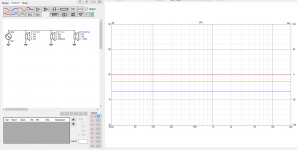
Now just mute the direct sound to inspect the reflections in isolation. Seated height, asymmetry to ceiling and floor path lengths are different and comb filter ensues. Notice though that the constructive interference is up about ~84db, louder than the direct sound.
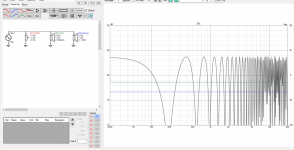
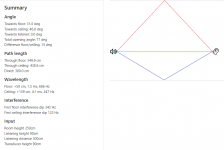
And now the path lengths are equalized, speaker (and listener) elevated some. Comb filter is gone as we have perfect symmetry. Now its clear to see the reflections, although attenuated, but when combined make together ~4db louder than direct sound (which was 80db).
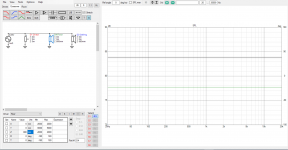
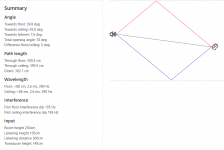
Perhaps there is no point thinking like this as I'm not sure how brain processes all this. Its nice to check out how sound sums up every now and then though 🙂
For completeness sake here is interference as all three sound sources are on, direct sound and the imaginary ceiling and floor ideal reflections:
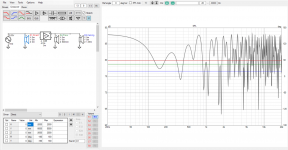
Here reflections are attenuated broadband additional 6db, 10db and 20db, one could think this as narrower coverage angle source or added acoustic treatment. Either done broad band require huge objects. It takes about 10db attenuation to get the resulting interference +/-6db terrirory and 20db attenuation takes it to measly +/-1db territory.
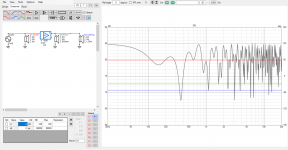
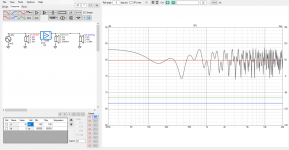
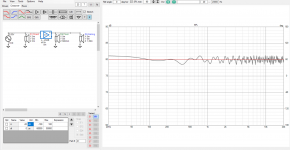
Main nugget in this post to demonstrate the first reflections really are loud and completely trump direct sound (1 direct sound vs 6 boundaries), but since they are delayed hearing system is able to process them out somewhat. If all 6 first reflections (floor, ceiling, four walls of a room) had different spectrum than direct sound, but similar to each other, steady state spectrum at listening position would be more like the reflections than the direct sound. If we have correlating spectrum on at least few of the reflections to direct sound and then the rest decorrelating we probably have good situation at listening position. Think how remarkable brain is to suppress the reflections as they come later, bring out the direct sound?🙂
Last edited:
Just a thought ( from my holiday stay). Griesinger has done extensieve research in direct vs indirect.
Perhaps some of his findings can help weigh the reflections better than a mic can.
Perhaps some of his findings can help weigh the reflections better than a mic can.
Thanks, need to revisit Griesinger papers. Meanwhile google dropped in this one https://www.whatsbestforum.com/thre...p-in-klippel-linkwitz-toole-and-geddes.29426/
Nothing wrong with having a vision like this, and making some assumptions based on it. However I would want to make a counter argument if I may, just to inspire some thought...Hmm, wondering about audibility of the "layers". Brain is obviously trying to keep the direct sound on surface and quite successfully hides reflections out of way, the background. Now lets think again a single layer, a phantom image due to floor and ceiling reflections (lets assume it happens, a phantom source from the two). Now we could raise the speaker and listener to mid height of the room, or if listener stays lower then raise the speaker more to equalize path lengths for the two reflections. This makes phase and level of the reflections correlate at ear. Not sure if this is necessary though, as decorrelated aka blurry background could sound better.
But, lets think what if the spectrums of the reflections are not similar to each other (and to direct sound)? What this would probably make is shift the image, on the bandwidth that doesn't correlate, towards either source, either reflection point. Kind of the idea from first post. As music is not constant pink noise we might perceive some image shifting in melodic parts or something, a layer that has life of its own, stuff jumping out from the order. This could be tested just with stereo speakers, EQ the other speaker differently and listen image shifts. Anyway, a moving layer is decorrelated to other layers doing their thing similarly but being at different angles relative to speaker perhaps have their own spectra, again decorrelating from the others some.
I speculate that brain has hard time to keep the moving background hidden consisting of moving layers. To help the brain do its job the least we could do is try keep the background images constant, if nothing else, even better keep them similar to the direct sound. This would mean smooth directivity speaker, with wide or narrow pattern, and positioned well so that early reflections get correlating sound. I would imagine that when the background is static, related to direct sound, without its own life, the brain gets more resources to enjoy the direct sound? 😀
Assumptions based on imaginary concept. You are welcome 😀
While it is a pretty common idea (just read Toole), to have similar off axis response in order to have the reflections similar in balance (and there's nothing wrong with that), I still view this idea of (early) reflections is somewhat hindering what I'd want, ideally, from my Stereo reproduction. As the dimensions of the speaker and floor/ceiling in relation to the listener stay the same (at least on the spot for ideal imaging etc.), all these floor and ceiling reflections do, is emphasize the size of the room, and drop that "image" over whatever is playing on the Stereo. That isn't what I want at all, it's kind of like "having the same sauce over everything" that is played back on a system like that. I wouldn't call it a static background, as it does drop it's size over the recording being played back...
That's the main reason for me to look at speakers that omit/avoid the floor and ceiling reflection (or even use it). And to avoid and/or absorb early reflections in favor of late lateral arriving reflections (still within the Haas limit) to have a clear shot of being able to hear the queues of 'space' that are already present in the recording itself (and not the queues of my own room size, which has nothing to do with the recording at all).
I'll admit to using trickery to enhance this, as I have a slight "Random Hall" reverb running on a couple of ambient speakers that function as my (decorrelated) Haas kickers (not on the main speakers!). A reverb, lightly used (not to attract any attention to itself) that varies along with, or based on the input. A lovely reverb development from Griesinger by the way. His papers sure were a big inspiration for my Haas Kicker project.
This way, a small ensemble recorded in a small room sounds: small. A huge orchestra in a large hall sounds: large. And I do not get a faulty impression of the artists I'm replaying being in "my room". Like having a 'scaled down' orchestra pushed inside to fit my too small a living room.
Anyway, that has been my goal to achieve and investigate. And I sure am glad I did. As it works well to hide the real properties of my room from the recording and it makes me feel more "there".
I realize this may not be to everyone's taste or liking, and that's perfectly fine. But it may change the ideas about floor and ceiling reflections as they are generally presented as 'not having a large influence' on our listening. I do not think I fully agree with that notion. Remove them to make up your (own) mind 😀.
Not a specific link as much as following a lot of discussion on gearspace.com. Yes, I've read some PDF's at the time, such as the one linked in that first post.
But the initial idea I got from joining the https://www.diymobileaudio.com/ website long ago and following the many lessons of member: Lycan, formerly
known there as werewolf (one and the same person and also a member here). He had a few very interesting talks about how to make a car sound bigger
than it is. That's what sparked my interest long ago and made me look at the works and papers of Griesinger. And as a consequence I read everything I could
find (literary) on Haas Kickers (which was a bit less than I'd expected). Gearspace (formerly Gearslutz) had a couple of interesting threads though.
The fun thing is that I found some answers that claimed 'Haas Kickers' were pretty much abandoned in recording studio concepts for they made everything
'sound a little better'. Not what you'd be looking for in a Studio, where you'd want to be critical of what you were hearing, but is it as bad for a listening room?
Or is it rather welcome there... it triggered me to go find out!
A very cool room was done by jim1961, a listening room with studio like qualities, set up for (pure) listening pleasure with a real Haas Kicker. I found out about this room
by reading and participating in this thread, but it's worth the read to check out his thread on gearspace. He and I had quite a few talks about Griesinger and using
reverb to further enhance the ideas (and listening pleasure). Griesinger was the driving part of Logic7, JBL made a car processor that featured it and it was being
used by a former JBL employee in Car audio competition which got noticed. Griesinger mentions the Lexicon 'Random Hall' reverb in some of his papers on the subject.
All in all it has been one of my most successful experiments. I've written about it in my array thread on multiple occasions, but like this post, it may get a bit long
winded 😀.
I hope that somewhat answers that question before I take up too much time.
But the initial idea I got from joining the https://www.diymobileaudio.com/ website long ago and following the many lessons of member: Lycan, formerly
known there as werewolf (one and the same person and also a member here). He had a few very interesting talks about how to make a car sound bigger
than it is. That's what sparked my interest long ago and made me look at the works and papers of Griesinger. And as a consequence I read everything I could
find (literary) on Haas Kickers (which was a bit less than I'd expected). Gearspace (formerly Gearslutz) had a couple of interesting threads though.
The fun thing is that I found some answers that claimed 'Haas Kickers' were pretty much abandoned in recording studio concepts for they made everything
'sound a little better'. Not what you'd be looking for in a Studio, where you'd want to be critical of what you were hearing, but is it as bad for a listening room?
Or is it rather welcome there... it triggered me to go find out!
A very cool room was done by jim1961, a listening room with studio like qualities, set up for (pure) listening pleasure with a real Haas Kicker. I found out about this room
by reading and participating in this thread, but it's worth the read to check out his thread on gearspace. He and I had quite a few talks about Griesinger and using
reverb to further enhance the ideas (and listening pleasure). Griesinger was the driving part of Logic7, JBL made a car processor that featured it and it was being
used by a former JBL employee in Car audio competition which got noticed. Griesinger mentions the Lexicon 'Random Hall' reverb in some of his papers on the subject.
All in all it has been one of my most successful experiments. I've written about it in my array thread on multiple occasions, but like this post, it may get a bit long
winded 😀.
I hope that somewhat answers that question before I take up too much time.
Last edited:
- Home
- Loudspeakers
- Multi-Way
- Vertical reflections, symmetric crossover and tilt -experiment